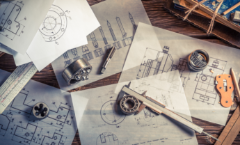The raw materials that go into the making of glass consist of sand, soda ash, limestone, feldspar, cullet (crushed glass of the same composition), plus small quantities of other chemicals and decolorizers. This mixture is called the batch.
The batch is delivered to the glass furnace at a predetermined rate where it is melted at approximately 2800 degrees Fahrenheit. The I.S. or individual section machine is the principal glass container machine used throughout the world today. The glass is delivered to the I.S. machine through channels called feeders. The glass is conditioned in the feeder to achieve the proper working temperature for the container being made on that feeder. At the end of the feeder the glass gob is formed through the orifice ring. After the gob is formed it is sheared off and it falls into the delivery system of the I.S. machine.
The two processes used to produce glass containers on the I.S. machine are the blow and blow process and the press and blow process.
Blow and Blow Process - Seven Major Steps of Production
- Gob LoadingThe gob of molten glass travels down the delivery system and enters the blank mold through the funnel. The funnel serves two purposes; first is to guide the gob into the blank mold without causing marks and second is to provide the seat for the baffle to start step two.
- SettleblowAfter the baffle has seated on the funnel compressed air enters the blank mold through the baffle and compresses the glass into the neck ring to form the finish of the container. Then the settleblow air shuts off, the baffle moves off of the funnel, the funnel moves off of the blank mold and the baffle moves onto the blank mold to seal the bottom of the blank mold.
- CounterblowWhile the baffle is moving to seal the bottom of the blank mold the plunger moves down from the finish and compressed air enters the finish through the plunger to blow the glass tight against the blank mold to form the parison. Once the parison is formed the counterblow air shuts off, the thimble moves down, the baffle moves off the blank mold and the blank mold opens.
- Transfer from the Blank Side to the Blow MoldThe neck ring holding the finish of the container inverts 180 degrees transferring the parison to the blow mold. The neck ring opens at the same time the blow mold closes to catch the parison under the transfer bead. The neck ring reverts and the parison forming cycle starts over.
- ReheatThe surface glass of the parison has become colder than the internal glass and therefore it must be allowed to reheat to a uniform temperature in order to prevent uneven distribution and cracks.
- Final BlowThe blowhead moves onto the top of the blow mold and compressed air enters the parison through the blowhead. The parison is blown tightly against the blow mold to form the final container shape.
- TakeoutThe final blow air shuts off, the blowhead moves off of the blow mold and the mold opens. The takeout moves in and picks the container off of the bottomplate. The takeout transfers the container to the cooling plate. The container is then pushed onto the conveyor belt where it travels to the annealing lehr.
Press and Blow Process
The difference between the press and blow process and the blow and blow process is that the parison is formed by pressing the shape. This process is used on containers with finish openings large enough to allow the plunger to enter to form the internal shape of the parison.







































